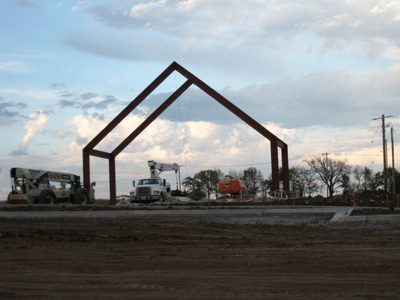Our History
St, Mary Magdalene started out in 2002 as a small band of dedicated Christians who met for Sunday Eucharist in the homes of various parishioners. By 2005 we had moved to McGilley’s Funeral Home on State Line Road. When McGilley’s was no longer available, we relocated to a storefront in a nearby shopping center on State Line Road.
We were a small congregation, but with many missions. We utilized every inch of space, including the worship space after the service, to carry out service projects like packing BackSnacks for local schools.
In 2009, we took a leap of faith and conducted a capital campaign for a new building. The campaign was successful, despite its timing being so close to the Great Recession, and we successfully raised the necessary funds to begin construction. The Diocese of Western Missouri purchased property in a growing area south of Kansas City, which included a house that would later become the House of Grace. The Bishop presided at the groundbreaking ceremony in late 2009.
Construction began soon afterwards, and we moved into our beautiful new building, which Bishop Barry Howe consecrated on July 31, 2010.

Who Was Saint Mary Magdalene?
Mary of Magdala, a town near Capernaum, was one of several women who followed Jesus and ministered to Him during His ministry in Galilee. The Gospel according to Luke tells us that Jesus “went on through cities and villages, preaching and bringing the good news of the kingdom of God. The Twelve were with him, as well as some women who had been healed of evil spirits and infirmities: Mary, called Magdalene, from whom seven demons had gone out” (Luke 8:1–2).
The Gospels testify that Mary was healed by Jesus, became His follower, and remained with Him even at the foot of the cross at Calvary. Her life was clearly and radically transformed by Jesus’ healing touch.
Mary’s ministry of devoted service and faithful companionship—especially her presence at the crucifixion—has stood through the centuries as a powerful witness to the role of women in the life and mission of Christ. All four Gospels name her among the women who went to the tomb to mourn and to care for Jesus’ body. Her weeping over the loss of her Lord resonates deeply with the grief all people feel at the death of a loved one.
In a moment of tender grace, Jesus meets her in the garden, reveals Himself to her by speaking her name, and makes her the first witness to His resurrection. He commissions her with the words, “Go to my brethren and say to them, ‘I am ascending to my Father and your Father, to my God and your God’” (John 20:17). Mary then goes and tells the disciples, “I have seen the Lord” (John 20:18).
In the tradition of the Church, Mary Magdalene is honored as “equal to the apostles” and “apostle to the apostles”—the first to proclaim the good news of the risen Christ.
-Adapted from Lesser Feasts and Fasts 2024
Growing Our Church for God’s Work
Donate to St. Mary Magdalene to help us grow in our ministry and outreach.

